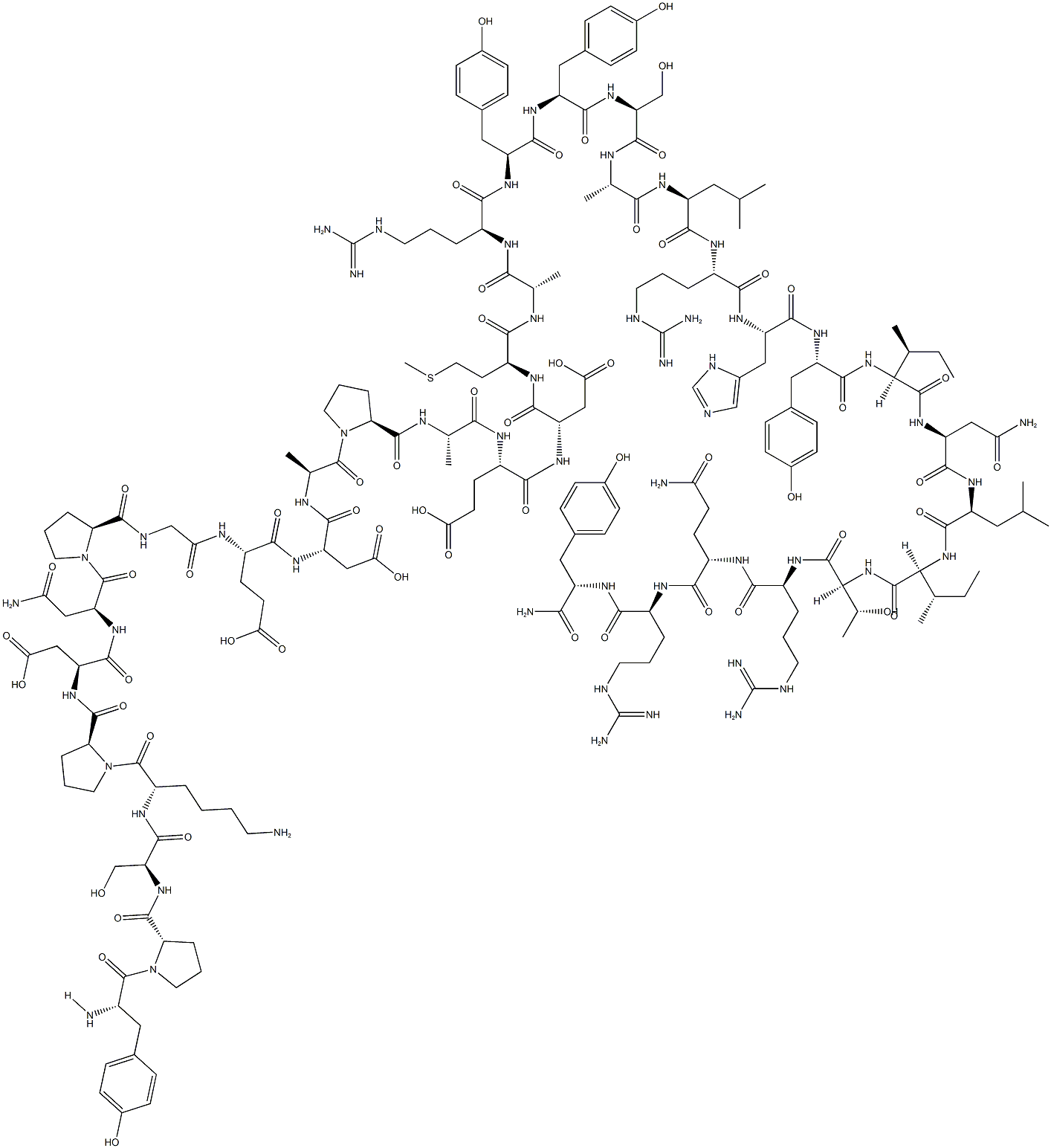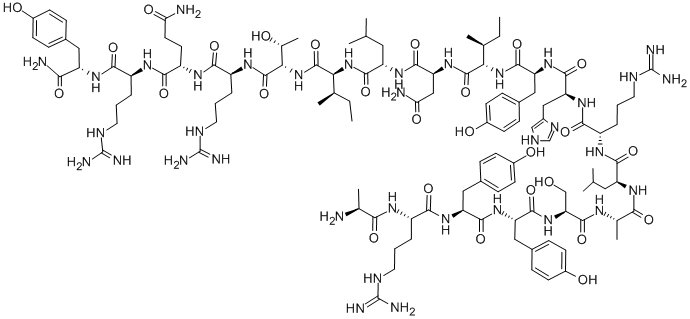NEUROPEPTIDE Y (HUMAN, RAT)
Synonym(s):hNPY;Neuropeptide Y, Human - CAS 90880-35-6 - Calbiochem;NPY;NPY, Human, YPSKPDNPGEDAPAEDMARYYSALRHYINLITRQRY-NH₂
- CAS NO.:90880-35-6
- Empirical Formula: C189H284N55O57RS
- Molecular Weight: 4270.67656
- MDL number: MFCD00212432
- Update Date: 2023-06-30 15:45:59

What is NEUROPEPTIDE Y (HUMAN, RAT)?
Description
Neuropeptide Y (NPY) is a peptide abundantly distributed throughout the central and peripheral nervous systems that plays a major role in controlling appetite, blood pressure, cardiac contractility, and intestinal secretion. Five subtypes of the NPY receptor have been identified. Subtypes Y1 and Y5 have known roles in the stimulation of feeding while Y2 and Y4 seem to have roles in satiety. NPY has also been shown to interact with the immune system, promoting gastrointestinal inflammation, as well as exhibiting an antimicrobial effect against several gut bacteria.
The Uses of NEUROPEPTIDE Y (HUMAN, RAT)
Neuropeptide Y (NPY) human has been used:
- to study the effect of antiepileptic effects on pentylenetetrazole (PTZ) rats.
- as a standard in high-performance liquid chromatography (HPLC) standard and control to verify specificity of the antibodies.
- to study the effect of NPY on motor and electroencephalographic (EEG) seizures induced by kainic acid.
What are the applications of Application
Neuropeptide Y is a potassium channel blocker, potent vasoconstrictor and reversible inhibitor of Ca2+-activated K+ channels
General Description
Neuropeptide Y is a regulatory molecule encoded by a gene mapped to human chromosome 7p15. Neuropeptide Y is a 36 amino acid protein with C-terminal α-amide structure. It is ubiquitously distributed in heart and brain, but at high levels in paraventricular hypothalamic nucleus, hypothalamic arcuate nucleus, suprachiasmatic nucleus, median eminence, dorsomedial, hypothalamic nucleus, paraventricular thalamic nuclei. NPY is a member of antimicrobial peptide family, which also include dermaseptins, cecropins or magainins.
Biochem/physiol Actions
Vasoconstrictor; brain peptide that inhibits Ca2+-activated K+ channels in vascular smooth muscle. Implicated in the control of blood pressure, sexual behavior and food intake. Inhibits cholecystokinin- and secretin-stimulated pancreatic secretion.
storage
-20°C (desiccate)
Properties of NEUROPEPTIDE Y (HUMAN, RAT)
| RTECS | QQ4064000 |
| storage temp. | −20°C |
| solubility | H2O: 1 mg/mL |
| form | powder |
| color | white |
| Water Solubility | Soluble in water (1.5 mg/ml) |
Safety information for NEUROPEPTIDE Y (HUMAN, RAT)
Computed Descriptors for NEUROPEPTIDE Y (HUMAN, RAT)
New Products
Tert-butyl bis(2-chloroethyl)carbamate 4-Methylphenylacetic acid N-Boc-D-alaninol N-BOC-D/L-ALANINOL 3-Morpholino-1-(4-nitrophenyl)-5,6-dihydropyridin- 2(1H)-one Furan-2,5-Dicarboxylic Acid Tropic acid 1,1’-CARBONYLDIIMIDAZOLE DIETHYL AMINOMALONATE HYDROCHLORIDE R-2-BENZYLOXY PROPIONIC ACID 1,1’-CARBONYLDI (1,2-4 TRIAZOLE) N-METHYL INDAZOLE-3-CARBOXYLIC ACID (2-Hydroxyphenyl)acetonitrile 4-Bromopyrazole 5-BROMO-2CYANO PYRIDINE 5,6-Dimethoxyindanone 5-broMo-2-chloro-N-cyclopentylpyriMidin-4-aMine 2-(Cyanocyclohexyl)acetic acid 4-methoxy-3,5-dinitropyridine 2-aminopropyl benzoate hydrochloride 1-(4-(aminomethyl)benzyl)urea hydrochloride diethyl 2-(2-((tertbutoxycarbonyl)amino) ethyl)malonate tert-butyl 4- (ureidomethyl)benzylcarbamate Ethyl-2-chloro((4-methoxyphenyl)hydrazono)acetateRelated products of tetrahydrofuran








You may like
-
 Neuropeptide Y, Human CAS 90880-35-6View Details
Neuropeptide Y, Human CAS 90880-35-6View Details
90880-35-6 -
 1975-50-4 98%View Details
1975-50-4 98%View Details
1975-50-4 -
 2-HYDROXY BENZYL ALCOHOL 98%View Details
2-HYDROXY BENZYL ALCOHOL 98%View Details
90-01-7 -
 2-Chloro-1,3-Bis(Dimethylamino)Trimethinium Hexafluorophosphate 221615-75-4 98%View Details
2-Chloro-1,3-Bis(Dimethylamino)Trimethinium Hexafluorophosphate 221615-75-4 98%View Details
221615-75-4 -
 61397-56-6 CIS BROMO BENZOATE 98%View Details
61397-56-6 CIS BROMO BENZOATE 98%View Details
61397-56-6 -
 14714-50-2 (2-Hydroxyphenyl)acetonitrile 98+View Details
14714-50-2 (2-Hydroxyphenyl)acetonitrile 98+View Details
14714-50-2 -
 118753-70-1 98+View Details
118753-70-1 98+View Details
118753-70-1 -
 733039-20-8 5-broMo-2-chloro-N-cyclopentylpyriMidin-4-aMine 98+View Details
733039-20-8 5-broMo-2-chloro-N-cyclopentylpyriMidin-4-aMine 98+View Details
733039-20-8